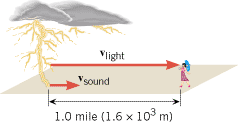There is a rule of thumb for estimating how far away a thunderstorm is. After you see a flash of lightning, count off the seconds until the thunder is heard. Divide the number of seconds by five. The result gives the approximate distance (in miles) to the thunderstorm. Why does this rule work?
Reasoning and Solution Figure 16.20 shows a lightning bolt and a person who is standing one mile (1.6![]() ×
×![]() 103 m) away. When the lightning occurs, light and sound (thunder) are produced very nearly at the same instant. Light travels so rapidly (vlight
103 m) away. When the lightning occurs, light and sound (thunder) are produced very nearly at the same instant. Light travels so rapidly (vlight![]() =
=![]() 3.0
3.0![]() ×
×![]() 108 m/s) that it reaches the observer almost instantaneously. Its travel time is only (1.6
108 m/s) that it reaches the observer almost instantaneously. Its travel time is only (1.6![]() ×
×![]() 103 m)/(3.0
103 m)/(3.0![]() ×
×![]() 108 m/s)
108 m/s)![]() =
=![]() 5.3
5.3![]() ×
×![]() 10–6 s. In comparison, sound travels very slowly (vsound
10–6 s. In comparison, sound travels very slowly (vsound![]() =
=![]() 343 m/s). The time for the thunder to reach the person is (1.6
343 m/s). The time for the thunder to reach the person is (1.6![]() ×
×![]() 103 m)/(343 m/s)
103 m)/(343 m/s)![]() =
=![]() 5 s. Thus, the time interval between seeing the flash and hearing the thunder is about 5 seconds for every mile of travel. This rule of thumb works because the speed of light is so much greater than the speed of sound that the time needed for the light to reach the observer is negligible compared to the time needed for the sound.
5 s. Thus, the time interval between seeing the flash and hearing the thunder is about 5 seconds for every mile of travel. This rule of thumb works because the speed of light is so much greater than the speed of sound that the time needed for the light to reach the observer is negligible compared to the time needed for the sound.
 |
|